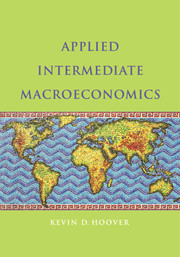Book contents
- Frontmatter
- Brief Contents
- Contents
- Acknowledgments
- To the Student
- To the Teacher
- Part I Introduction
- Part II The National Accounts
- Part III Trends and Cycles
- Part IV Financial Markets
- Part V Aggregate Supply
- 9 Aggregate Production
- 10 Economic Growth
- 11 The Ideal Labor Market
- 12 Unemployment and the Labor-Market Process
- Part VI Aggregate Demand
- Part VII Macroeconomic Dynamics
- Part VIII Macroeconomic Policy
- Part IX Macroeconomic Data
- Symbols
- Glossary
- Guide to Online Resources
- Index
- References
11 - The Ideal Labor Market
from Part V - Aggregate Supply
Published online by Cambridge University Press: 05 June 2012
- Frontmatter
- Brief Contents
- Contents
- Acknowledgments
- To the Student
- To the Teacher
- Part I Introduction
- Part II The National Accounts
- Part III Trends and Cycles
- Part IV Financial Markets
- Part V Aggregate Supply
- 9 Aggregate Production
- 10 Economic Growth
- 11 The Ideal Labor Market
- 12 Unemployment and the Labor-Market Process
- Part VI Aggregate Demand
- Part VII Macroeconomic Dynamics
- Part VIII Macroeconomic Policy
- Part IX Macroeconomic Data
- Symbols
- Glossary
- Guide to Online Resources
- Index
- References
Summary
Labor is the most important factor of production. Most of us are workers and derive our main source of income from labor. In this chapter, we investigate the labor markets when they are working well. Some of the questions considered are: How much labor do firms want to hire? How many people want to work? For how long? How do taxes, technological progress, and immigration affect real wages? In the next chapter, we consider the problem of unemployment.
In the last two chapters we investigated the determination of aggregate supply. The key question was, looking at the economy from the point of view of the firm sector, what determines the amount of GDP produced? The simple answer was technology and factor inputs. That answer is only partial in the sense that it immediately raises the question, what determines technology and factor inputs? Although we touched on this question in the earlier chapters, our answer – especially with respect to factor inputs – was limited. We have a special interest in the answer because ordinary people provide the labor input and it forms the basis for most incomes in the economy. In this chapter we ask what in ideal circumstances (i.e., when the economy is running smoothly and all markets are in equilibrium) determines the amount of labor available to production. The analysis can be applied with appropriate modifications to capital as well. We concentrate on labor because of its overwhelming importance to the typical person.
The nearly universal answer to all economic questions is supply and demand. If we wish to know why a certain amount of labor is available and used in the production process, a good starting place is to notice that firms demand labor and workers supply it. Our analysis, then, has three parts: (1) What factors govern the decisions of firms to hire labor? (2) What factors govern the willingness of workers to supply it? (3) How do the decisions of firms and workers interact to determine the amount of labor used in production?
- Type
- Chapter
- Information
- Applied Intermediate Macroeconomics , pp. 405 - 442Publisher: Cambridge University PressPrint publication year: 2011



